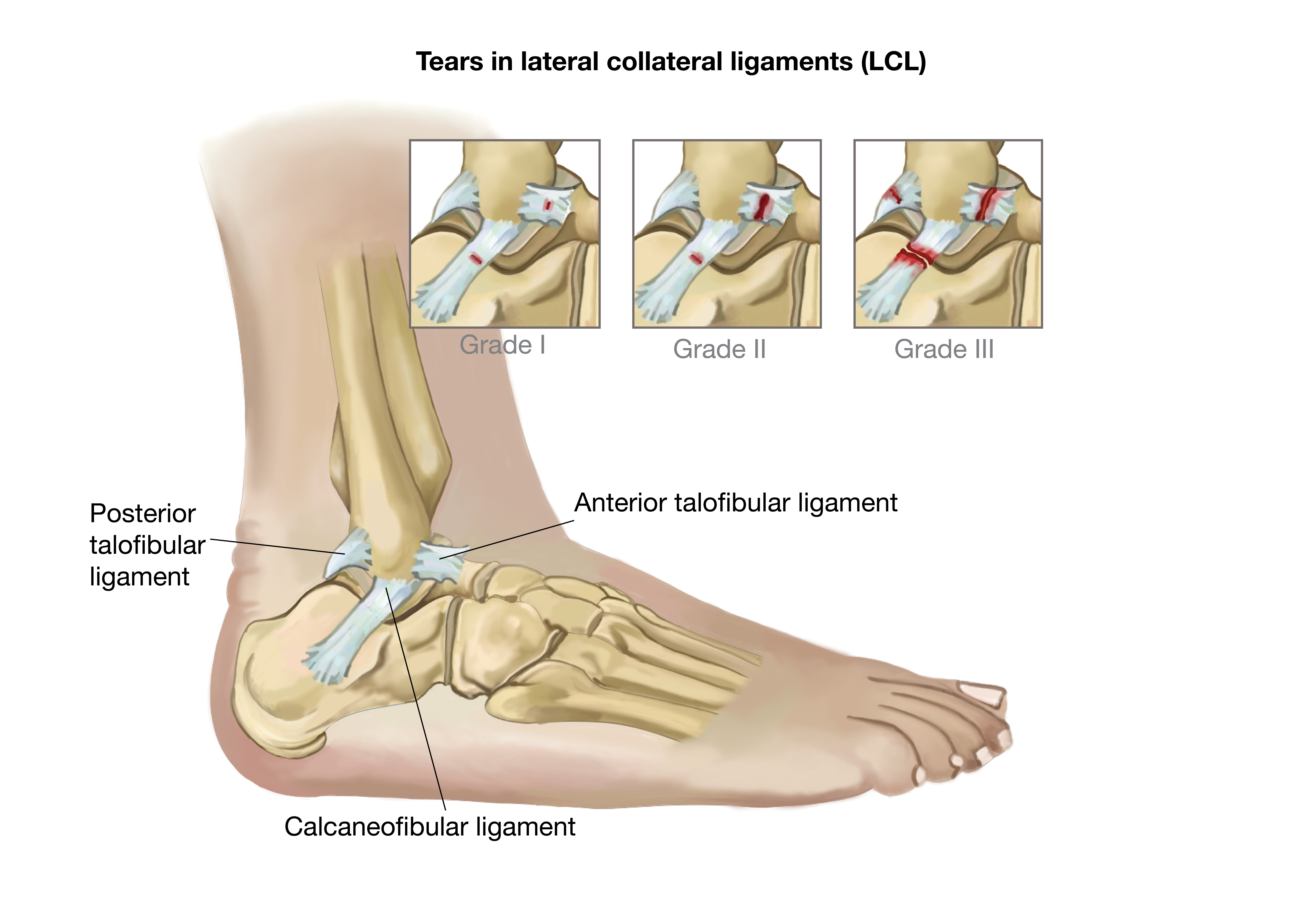Lateral ankle ligament injuries
Information for patients from Trauma and Orthopaedics (T&O)
You have been diagnosed with a lateral ankle ligament injury. This leaflet will explain:
what ankle instability is
what the treatment options are
what risks there are to having surgery; and
what happens if I choose not to have an operation.
We hope this leaflet helps to answer some of the questions you may have. If you have any further questions or concerns, please speak to a member of your healthcare team.
What is ankle instability?
The ankle joint is supported by the soft tissue around it. When the ankle rolls over, the soft tissue can become stretched, disrupted, or completely torn.
Around the ankle, the ligaments on the outer (lateral) side are most often affected by this type of injury.

What causes ankle instability?
Trauma (injury) is the most common cause. However, some patients may also have hypermobility. Hypermobility is a condition where the patient's joints are more flexible than normal.
What are the symptoms?
Normally there is pain and swelling around the injured area. This may be linked with instability when walking or running.
What happens if I ignore the condition?
The reason(s) why you came to the appointment may not get better and sometimes can get worse. It is difficult to predict.
What are the treatment options?
The first treatment for all ankle sprains without a fracture, is protection of the joint. This includes using:
an ankle brace or walking boot
a rest (crutches)
compression (sometimes a compression bandage helps); and
elevation (raising your ankle).
Painkillers (such as paracetamol and ibuprofen) and non-steroidal anti-inflammatory medication may also be used.
Physiotherapy will help with recovery.
You should only consider surgery after you have tried the treatments listed above, and your pain and symptoms of instability continue.
What happens during surgery?
During this surgery, the lax ligaments are first taken off the bone. The ligaments are secured with a special stitch, and reattached by drill holes into a bony channel made on the bone (fibula for lateral structures). Repair of the overlying tissue (retinaculum) is reinforced by this tightening procedure as well.
You will discuss this procedure with your surgeon before any treatment is decided. You will have a chance to ask questions or raise any concerns you may have.
Will I have a general anaesthetic?
The surgery is normally carried out under general anaesthesia (you will be asleep).
You will be told at your pre-assessment appointment:
when to stop eating and drinking
what to do with your medications; and
where to go on the day of your surgery.
How long will I have to stay in hospital?
This surgery is performed as a day case procedure (you will able to go home the same day).
You will need someone to drive you home after your surgery, and someone must stay with you overnight.
What happens when I arrive at the hospital?
When you arrive at the hospital you will be seen by the nurses, a physiotherapist, and doctors who will explain your procedure. Please use this time to ask any questions.
You will be asked to change into a hospital gown and stockings.
How will I feel after my surgery?
After surgery, you will be given painkillers to help with any discomfort. Everyone reacts to the anaesthetic differently. Feeling sick is common and we do our best to avoid this.
What happens after surgery?
Your leg will be placed in a below-knee cast for 2 weeks.
Two weeks after your surgery your wound will be checked. A complete below-knee cast will be fitted for a further 4 weeks.

For the first 6 weeks after your surgery, do not put any weight on your affected leg. A member of your healthcare team will give you crutches for support. Please use these as advised by your doctor.
You must elevate (raise) your ankle as much as possible.
Six weeks after your surgery you will be fitted with a walking boot. You can weight-bear whilst wearing the boot. Physiotherapy will also begin at this time.
When can I start my normal activities again?
Six weeks after your operation, you should be able to return to non-impact sports. You cannot start impact sports again until 12 weeks.
When can I drive again?
This is a difficult question to answer. Your healthcare professionals are not able to take responsibility for this.
You need to check with your insurance company about when they will be willing to insure you to drive again. You must not be in a cast or boot when driving. You must be able to do an emergency stop safely before driving again.
When can I return to work?
When you can return to work depends on the amount of weightbearing needed in your job. If you sit down a lot at work and you can keep your foot elevated, you can return 6 to 8 weeks after your operation. Otherwise you should expect to return to work after 12 to 16 weeks.
What are the risks?
As with any surgery there are risks. Your surgeon will discuss these with you in more detail before your procedure.
Common complications of this type of surgery include the following.
You can expect swelling for up to 6 months, particularly in the evenings.
Infection rates are low, and antibiotics are given before any surgery. If you do develop an infection, this can cause problems.
A skin infection can be managed with antibiotics.
If you develop a deep infection, we may need to remove any unhealthy bone. You will also need a long course of antibiotics.
Nerve injury can result in numbness or tingling over your foot. This is usually temporary, but in a small number of cases it may become permanent.
Rarely, sutures (stitches) can become prominent (jut out). This can cause pain from irritation of the overlying soft tissues (including your muscles and tendons). If this continues, the sutures may need to be removed.
Complex Regional Pain Syndrome (CRPS) can develop when the nerves around the operation site become overly sensitive. Swelling, skin changes, and stiffness can happen and can make you feel weak. This is uncommon, but if it does happen it is usually managed by a specialist in pain management.
Deep Vein Thrombosis (DVT) / Pulmonary Embolism (PE) is rare with this surgery. Anticoagulation medication is given after surgery, to try to prevent clots forming whilst you are not able to move your leg. This is a preventative measure, but a clot can still form.
If you have any concerns or questions about any of these risks, please speak with your doctor before your surgery.
What if I have any questions or concerns once I return home?
If you have any questions before your surgery, contact the team secretary through the hospital switchboard.
After surgery you can call the team secretary, the ward, or your GP if you have any further concerns or questions. If you have concerns and cannot get in touch with anyone, go to your nearest Emergency Department.
Ask 3 Questions
There may be choices to make about your healthcare. Before making any decisions, make sure you get the answers to these three questions:
What are my choices?
What is good and bad about each choice?
How do I get support to help me make a decision that is right for me?
Your healthcare team needs you to tell them what is important to you. It’s all about shared decision making.
What do you think of this leaflet?
We welcome feedback, whether positive or negative, as it helps us to improve our care and services.
If you would like to give us feedback about this leaflet, please fill in our short online survey. Either scan the QR code below, or use the web link. We do not record your personal information, unless you provide contact details and would like to talk to us some more.
If you would rather talk to someone instead of filling in a survey, please call the Patient Voice Team.
Patient Voice Team
Telephone: 01227 868605
Email